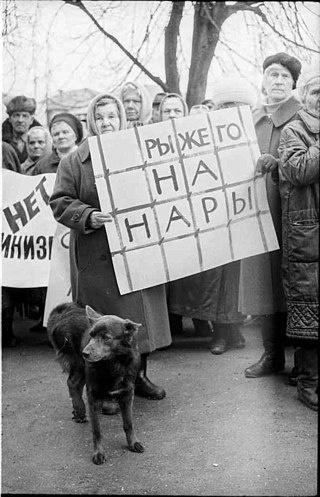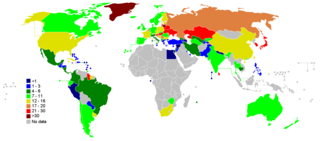Related Research Articles

A copycat suicide is defined as an emulation of another suicide that the person attempting suicide knows about either from local knowledge or due to accounts or depictions of the original suicide on television and in other media. The publicized suicide serves as a trigger, in the absence of protective factors, for the next suicide by a susceptible or suggestible person. This is referred to as suicide contagion.

The AIDS epidemic, caused by HIV, found its way to the United States between the 1970s and 1980s, but was first noticed after doctors discovered clusters of Kaposi's sarcoma and pneumocystis pneumonia in homosexual men in Los Angeles, New York City, and San Francisco in 1981. Treatment of HIV/AIDS is primarily via the use of multiple antiretroviral drugs, and education programs to help people avoid infection.
There are more than 700,000 estimated suicide deaths every year. Suicide affects every demographic, yet there are some populations that are more impacted than others. For example, among 15–29 year olds, suicide is much more prominent; this being the fourth leading cause of death within this age group.

The Special Period, officially the Special Period in the Time of Peace, was an extended period of economic crisis in Cuba that began in 1991 primarily due to the dissolution of the Soviet Union and the Comecon. The economic depression of the Special Period was at its most severe in the early to mid-1990s. Things improved towards the end of the decade once Hugo Chávez's Venezuela emerged as Cuba's primary trading partner and diplomatic ally, and especially after the year 2000 once Cuba–Russia relations improved under the presidency of Vladimir Putin.
Farmer suicides in India refers to the national catastrophe of farmers dying by suicide since the 1970s, due to their inability to repay loans mostly taken from private landlords and banks. NCRB data shows that the incidence of farmer suicides has remained high in the 6 years between 2014 and 2020. 5,600 farmers died by suicide in 2014, and 5,500 farmers died by suicide in 2020. If the agricultural labourers are added to the 2020 number, the number of suicides rises to over 10,600.
The actions by governments of communist states have been subject to criticism across the political spectrum. Communist party rule has been especially criticized by anti-communists and right-wing critics, but also by other socialists such as anarchists, trotskyists, democratic socialists, libertarian socialists and orthodox Marxists. Ruling communist parties have also been challenged by domestic dissent. According to the critics, rule by communist parties has often led to totalitarianism, political repression, restrictions of human rights, poor economic performance, and cultural and artistic censorship.
Communism is a left-wing to far-left sociopolitical, philosophical, and economic ideology within the socialist movement, whose goal is the creation of a communist society, a socioeconomic order centered around common ownership of the means of production, distribution, and exchange that allocates products to everyone in the society based on need. A communist society would entail the absence of private property and social classes, and ultimately money and the state.
Labour in India refers to employment in the economy of India. In 2020, there were around 476.67 million workers in India, the second largest after China. Out of which, agriculture industry consist of 41.19%, industry sector consist of 26.18% and service sector consist 32.33% of total labour force. Of these over 94 percent work in unincorporated, unorganised enterprises ranging from pushcart vendors to home-based diamond and gem polishing operations. The organised sector includes workers employed by the government, state-owned enterprises and private sector enterprises. In 2008, the organised sector employed 27.5 million workers, of which 17.3 million worked for government or government owned entities. The Human Rights Measurement Initiative finds that India is only doing 43.9% of what should be possible at its level of income for the right to work. Employees are routinely taken advantage of by their employers because of loose labour laws across all industries in India.
In Japan, suicide is considered a major social issue. In 2017, the country had the seventh highest suicide rate in the OECD, at 14.9 per 100,000 persons, and in 2019 the country had the second highest suicide rate among the G7 developed nations.

Crime in Russia refers to the multivalent issues of organized crime, extensive political and police corruption, and all aspects of criminality at play in Russia. Violent crime in Siberia is much more apparent than in Western Russia.

Suicide is the act of intentionally causing one's own death. Mental disorders, physical disorders, and substance abuse are risk factors. Some suicides are impulsive acts due to stress, relationship problems, or harassment and bullying. Those who have previously attempted suicide are at a higher risk for future attempts. Effective suicide prevention efforts include limiting access to methods of suicide such as firearms, drugs, and poisons; treating mental disorders and substance abuse; careful media reporting about suicide; improving economic conditions; and dialectical behaviour therapy (DBT). Although crisis hotlines are common resources, their effectiveness has not been well studied.

Privatization in Russia describes the series of post-Soviet reforms that resulted in large-scale privatization of Russia's state-owned assets, particularly in the industrial, energy, and financial sectors. Most privatization took place in the early and mid-1990s under Boris Yeltsin, who assumed the presidency following the dissolution of the Soviet Union.

A military commissariat, is an institution that is part of military service or law enforcement mechanisms in some European countries. As part of the British Army in the 19th century, military commissariats were used for organisational, accounting and bookkeeping duties regarding military transport, personnel and equipment. The most widespread historic use of military commissariats existed as part of administrative military infrastructure in the Soviet Union. Each Soviet district would have a military commissariat that was responsible for keeping documentation up to date concerning military resources, including the labour force, in their region. Military commissariats in the Soviet Union were also tasked with the recruitment and training of military servicemen. The use of military commissariats as local military administrative agencies continued as a part of modern Russia after the dissolution of the Soviet Union in 1991. There has been criticism and speculation regarding corruption in the recruitment process of military personnel and allegations of an abusive military culture in commissariats since their inception. This has caused the role of military commissariats as administrative agencies to be questioned. Buildings that were military commissariats still serve their purpose in Russia and some other post-Soviet states. In France and Italy, the word "commissariat" can refer to factions of the police and law enforcement, some of whom are connected to the military.

Gender differences in suicide rates have been shown to be significant. There are different rates of suicides and suicidal behavior between males and females. While females more often have suicidal thoughts, males die by suicide more frequently. This discrepancy is also known as the gender paradox in suicide.
Alcohol consumption in Russia remains among the highest in the world. According to a 2011 report by the World Health Organization, annual per capita consumption of alcohol in Russia was about 15.76 litres of pure alcohol, the fourth-highest volume in Europe. It dropped to 11.7 litres in 2016, dropping further to about 10.5 litres in 2019. Another general trait of Russian alcohol consumption pattern was the high volume of spirits compared with other alcoholic drinks.
Health in Russia deteriorated rapidly following the dissolution of the Soviet Union, and particularly for men, as a result of social and economic changes.

About 800,000 people die by suicide worldwide every year. 164,033 Indians committed suicide in 2021 and the national suicide rate was 12, which is the highest rate of deaths from suicides since 1967, which is the earliest recorded year for this data. According to The World Health Organization, in India, suicide is an emerging and serious public health issue.

According to the latest available data, Statistics Canada estimates 4,157 suicides took place in Canada in 2017, making it the 9th leading cause of death, between Alzheimer's disease (8th) and cirrhosis and other liver diseases (10th). In 2009, there were an estimated 3,890 suicide deaths.
Suicide in Russia is a significant national social issue, with the suicide rate at 21.6 suicides per 100.000 people. In 2021, the suicide rate in Russia was 10.7 per 100,000 people, according to national sources, down from 39.1 in 2000 and 41.4 in 1995. Since 2002 the number of suicides has fallen in each consecutive year and has dropped to its lowest level in more than 50 years.
The dowry system in India refers to the durable goods, cash, and real or movable property that the bride's family gives to the groom, his parents and his relatives as a condition of the marriage. Dowry is called "दहेज" in Hindi and as جہیز in Urdu.
References
- ↑ E Brainerd (2001), "Economic reform and mortality in the former Soviet Union: a study of the suicide epidemic in the 1990s", European Economic Review, 45 (4–6): 1007–1019, doi:10.1016/S0014-2921(01)00108-8, S2CID 154383668
- ↑ JM Violanti (2007). Police suicide: Epidemic in blue. Charles C Thomas Publisher. ISBN 978-0-398-07762-4.
- ↑ JA Ward, J Fox (1977), A suicide epidemic on an Indian reserve, Canadian Psychiatric Association Journal
- ↑ FX Hezel (1987), Truk suicide epidemic and social change (PDF), Human Organization
- ↑ J Thorson, PA Öberg (2003), Was There a Suicide Epidemic After Goetheʼs Werther? (PDF), Archives of Suicide Research
- ↑ DM Stupple (1987), "Rx for the suicide epidemic", English Journal, 76 (1): 64–68, doi:10.2307/818306, JSTOR 818306